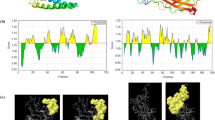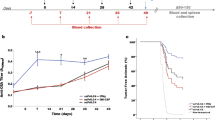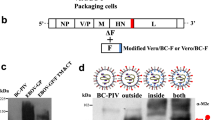Abstract
An assessment was made of the effectiveness of DNA vaccination in prevention of the mammary adenocarcinomas of BALB/c female mice transgenic for the activated rat Her-2/neu oncogene. Atypical hyperplasia is evident in their mammary glands when they are 6 weeks old and in situ carcinoma by the 13th week. Palpable invasive carcinomas appear around the 17th week and are always evident in all 10 glands by the 33rd week. Intramuscular vaccinations with 100 μg plasmid DNA encoding the extracellular domain of the Her-2/neu p185 (ECD) performed at the 6th, 12th, 18th and 24th week provided no significant protection, whereas those ECD plasmids in which the DNA coding for the immunomodulatory 163–171 (VQGEESNDK) nonapeptide of human IL1β (ECD-IL1βp) had been inserted both delayed carcinogenesis and reduced tumor multiplicity. This reduction was associated with a marked immune-inflammatory reaction and a conspicuous leukocyte infiltrate located in the stroma surrounding the hyperplastic mammary ductul-alveolar structures. It was also directly correlated with a high anti-p185neu antibody production and an immunoglobulin switch to IgG2a and IgA. No anti-p185neu cytotoxic response was found. No significant protection was obtained when the DNA coding for the non-active peptide 189–197 of IL1β was inserted.
This is a preview of subscription content, access via your institution
Access options
Subscribe to this journal
Receive 12 print issues and online access
$259.00 per year
only $21.58 per issue
Buy this article
- Purchase on Springer Link
- Instant access to full article PDF
Prices may be subject to local taxes which are calculated during checkout




Similar content being viewed by others
References
Calarota SA et al. Immune responses in asymptomatic HIV-1-infected patients after HIV-DNA immunization followed by highly active antiretroviral treatment J Immunol 1999 163: 2330–2338
Boyer JD et al. Vaccination of seronegative volunteers with a human immunodeficiency virus type1 env/rev DNA vaccine induces antigen-specific proliferation and lymphocyte production of beta-chemokines J Infect Dis 2000 181: 474–483
Le TP et al. Safety, tolerability and humoral immune responses after intramuscular administration of a malaria DNA vaccine to healthy adult volunteers Vaccine 2000 18: 1893–1901
Kumar V, Sercarz E . Genetic vaccination: the advantages of going naked Nat Med 1996 2: 857–859
Levitsky H . Accessories for naked DNA vaccination Nat Biotechnol 1997 15: 619–620
Boyle JS, Brady JL, Lew AM . Enhanced responses to a DNA vaccine encoding a fusion antigen that is directed to sites of immune induction Nature 1998 392: 408–411
Forni G, Boggio K . Cytokine gene-engineered vaccines Curr Opin Ther 1999 1: 34–38
Musiani P et al. Cytokines, tumor cell death and immunogenicity: a question of choice Immunol Today 1997 18: 32–36
Tao MH, Levy R . Idiotype/granulocyte–macrophage colony-stimulating factor fusion protein as a vaccine for B cell lymphoma Nature 1993 362: 755–758
Staruch MJ, Wood DD . The adjuvanticity of interleukin 1 in vivo J Immunol 1983 130: 2191–2194
Boraschi D et al. In vivo stimulation and restoration of the immune response by the noninflammatory fragment 163–171 of human interleukin 1β J Exp Med 1988 168: 675–686
Forni G, Musso T, Giovarelli M . Lymphokine-activated tumor inhibition in mice. Ability of a nonapeptide of human IL1β to recruit anti-tumor reactivity in recipient mice J Immunol 1989 142: 712–718
Beckers W et al. Increasing the immunogenicity of protein antigens through the genetic insertion of VQGEESNDK sequence of human IL-1 beta into their sequence J Immunol 1993 51: 1757–1764
Chen TT, Tao MH, Levy R . Idiotype-cytokine fusion proteins as cancer vaccines. Relative efficacy of IL-2, IL-4, and granulocyte–macrophage colony-stimulating factor J Immunol 1994 153: 4775–4787
Boggio K et al. Interleukin-12 mediated prevention of spontaneous mammary adenocarcinomas in two lines of Her-2/neu transgenic mice J Exp Med 1998 188: 589–596
Di Carlo E et al. Analysis of mammary carcinoma onset and progression in Her-2/neu oncogene transgenic mice reveals a lobular origin Lab Invest 1999 79: 1261–1269
Amici A, Venanzi FM, Concetti A . Genetic immunization against neu/erbB2 transgenic breast cancer Cancer Immunol Immunother 1998 477: 183–190
Amici A et al. DNA vaccination with full-length or truncated Neu induces protective immunity against the development of spontaneous mammary tumors in HER-2/neu transgenic mice Gene Therapy 2000 7: 703–706
Rovero S et al. DNA vaccination against rat Her-2/Neu p185 more effectively inhibits carcinogenesis than transplantable carcinomas in transgenic BALB/c mice J Immunol 2000 165: 5133–5142
Drebin JA et al. Down-modulation of an oncogene protein product and reversion of the transformed phenotype by monoclonal antibodies Cell 1985 41: 697–706
Katsumata M et al. Prevention of breast tumors development in vivo by downregulation of the p185neu receptor Nat Med 1995 1: 644–648
Kappler NL et al. A subclass of tumor-inhibitory monoclonal antibodies to ErbB-2/HER2 blocks crosstalk with growth factor receptors Oncogene 1997 14: 2099–2109
Xu F et al. Antibody-induced growth inhibition is mediated through immunochemically and functionally distinct epitopes on the extracellular domain of c-erbB-2 (Her-2/neu) gene product p185 Int J Cancer 1993 53: 401–408
Drebin JA, Link VC, Winberg RA, Greene MI . Inhibition of tumor growth by a monoclonal antibody reactive with an oncogene-encoded tumor antigen PNAS 1986 83: 9129–9133
Drebin JA, Link VC, Greene MI . Monoclonal antibodies specific for the neu oncogene product directly mediate anti-tumor effects in vivo Oncogene 1988 2: 387–394
Pegram MD, Slamon DJ . Combination therapy with trastuzumab (Herceptin) and cisplatin for chemoresistant metastatic breast cancer: evidence for receptor-enhanced chemosensitivity Semin Oncol 1999 26: 89–95
Giovarelli M, Santoni A, Forni G . Alloantigen-activated lymphocytes from mice bearing a spontaneous ‘nonimmunogenic’ adenocarcinoma inhibit its growth in vivo by recruiting host immune reactivity J Immunol 1985 133: 3596–3603
Cavallo F et al. Immune events associated with the cure of established tumors and spontaneous metastases by local and systemic IL-12 Cancer Res 1999 59: 414–421
Cavallo F et al. Antitumor efficacy of adenocarcinoma cells engineered to produce IL-12 or other cytokines compared with exogenous IL-12 J Natl Cancer Inst 1997 89: 1049–1058
Huls G et al. Antitumor immune effector mechanisms recruited by phage display-derived fully human IgG1 and IgA1 monoclonal antibodies Cancer Res 1999 59: 5778–5784
Shen L, Fanger MW . Secretory IgA antibodies synergize with IgG in promoting ADCC by human polymorphonuclear cells, monocytes and lymphocytes Cell Immunol 1981 59: 75–81
Nanni P et al. p185neu protein is required for tumor and anchorage-independent growth, not for cell proliferation of transgenic mammary carcinoma Int J Cancer 2000 87: 186–194
Pericle F et al. An efficient Th-2-type memory follows CD8+ lymphocyte driven and eosinophil-mediated rejection of a spontaneous mouse mammary adenocarcinoma engineered to release IL-4 J Immunol 1994 153: 5659–5673
Giovarelli M et al. Local release of IL-10 by transfected mouse mammary adenocarcinoma cells does not suppress but enhances antitumor reaction and elicits a strong cytotoxic lymphocyte and antibody-dependent immune memory J Immunol 1995 155: 3112–3123
Acknowledgements
We thank Dr John Iliffe for critical review of the manuscript. This work was supported by the Italian Association for Cancer Research, the Istituto Superiore di Sanità, Special project gene therapy, CNR Target project on Biotechnology, Ministero dell'Università e della Ricerca Scientifica, and by the Department of Army, USA, Grant DAMD17–98–1-8030 (to Guido Forni). The information contained in this paper does not necessarily reflect the position or the policy of the US government, and no official endorsement should be inferred.
Author information
Authors and Affiliations
Rights and permissions
About this article
Cite this article
Rovero, S., Boggio, K., Carlo, E. et al. Insertion of the DNA for the 163–171 peptide of IL1β enables a DNA vaccine encoding p185neu to inhibit mammary carcinogenesis in Her-2/neu transgenic BALB/c mice. Gene Ther 8, 447–452 (2001). https://doi.org/10.1038/sj.gt.3301416
Received:
Accepted:
Published:
Issue Date:
DOI: https://doi.org/10.1038/sj.gt.3301416
Keywords
This article is cited by
-
Fighting breast cancer stem cells through the immune-targeting of the xCT cystine–glutamate antiporter
Cancer Immunology, Immunotherapy (2019)
-
HER-2/neu-gene engineered dendritic cell vaccine stimulates stronger HER-2/neu-specific immune responses compared to DNA vaccination
Gene Therapy (2006)
-
Vaccines for tumour prevention
Nature Reviews Cancer (2006)
-
The promise of genetically engineered mice for cancer prevention studies
Nature Reviews Cancer (2005)
-
Immune prevention of mammary carcinogenesis in HER-2/neu transgenic mice: a microarray scenario
Cancer Immunology, Immunotherapy (2005)



